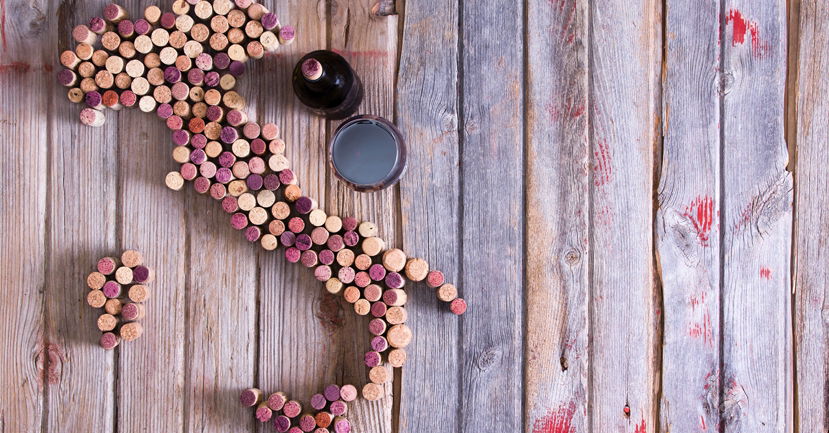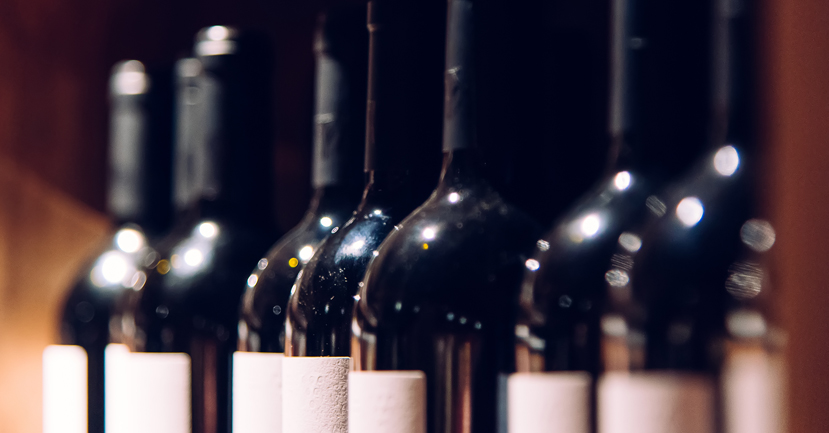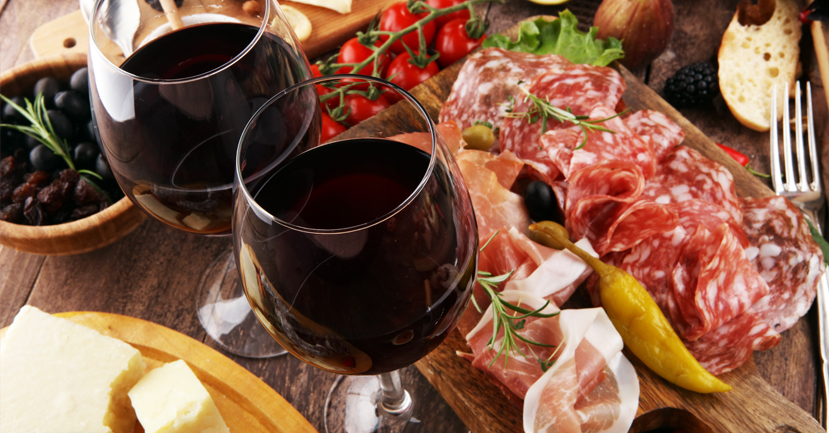BLOG
25 Italian Wine Terms You Need To Know
Andrea Eby
Wine Education & Careers

The Italian wine world is full of wine-related terminology that many consumers struggle to understand. Learning the meaning of a few key terms can increase your confidence level and help you make informed decisions when selecting your next glass, or bottle, of vino. We have compiled a list of 25 common terms and phrases that we know will help you navigate the delicious world of vino Italiano!
Label Lingo
Italian wine labels can, to the uninitiated, look confusing and intimidating; however, learn a few simple terms and you will be decoding labels like a pro.
1. DOCG – Denominazione di Origine Controllata e Garantita
It’s a mouthful, but essentially it means that a wine is at the very top of the Italian wine classification system. To be granted the DOCG classification wines must come from small delimited areas and be produced according to stringent criteria. Many of Italy’s most famous wines are DOCG wines; Brunello, Barbaresco and Chianti Classico are but just a few of the many examples.
2. DOC – Denominazione di Origine Controllata
Although these wines are one step down the classification ladder from DOCG, DOC wines must also adhere to a rigorous set of rules and regulations. They too come from delimited areas (often larger than that of DOCGs). The DOC category is a great place to begin your exploration into the fascinating world of Italian wine.
3. IGT – Indicazione Geografica Tipica
This category represents the middle of the Italian wine quality pyramid. While still being defined by geographical areas, winemakers looking to blend in non-traditional grape varieties, source from a wider geographical area, or employ less mainstream winemaking techniques are often drawn to the freedom and flexibility that this category offers. Don’t be fooled into thinking that fewer rules mean lower quality, some of Italy’s most famous (and expensive) wines fall under this umbrella (see Super Tuscans, below).
4. Vino da Tavola
This is the traditional name for “table wine.” This term has been recently been replaced on labels with only the word “vino,” but it means the same thing; these wines are generally produced from grapes grown outside of appellation boundaries and are often blends from multiple appellations. Very little additional info is allowed on the label. Producers can tell you if the wine is red, white or rosé, but the grape variety is not to be stated (with a few exceptions). The wines can range from humble, honest examples to trendy, top-end tipples from winemakers looking to produce wines without stifling rules and regulations.
5. Super Tuscan
An unofficial category of Tuscan wine that rose to prominence in the 1980s. Originally, used to differentiate wines that utilized grapes that were not native to Italy. These red wines often incorporated Cabernet Sauvignon, Merlot, Cabernet Franc and/or Syrah into the mix (in regions where such grape varieties were officially barred from being included in DOC or DOCG wines). Famous wines such as “Tignanello” and “Sassicaia” all began their legacies as “Super Tuscans.” The creation of the IGT category (outlined above) was partially in response to the rise in popularity of these innovative, and sometimes expensive wines.
6. Vigna
A single vineyard; the term vigna is followed by the name of the vineyard. This designation can only be used if the grapes come from that named vineyard. The wines must follow stricter production criteria than non-single vineyard wines from the same DOC or DOCG. Single vineyard wines are often more expensive than multi-vineyard bottlings.
7. Produttore
Literally translated as “producer”, the term is one of many terms that can give you more information on where the wine was made. Other commonly encountered terms include: podere (small estate), fattoria (farm), cascina (farmhouse), poggio (hill) and azienda agricola (a farming business that grows grapes and produces wine).

Points for Style…
There are hundreds of thousands of different wines on the market, but the vast majority can be broken down into categories of style. Do you like dry red wines? Or, sweet whites? Whatever your preference, understanding Italian wine style terms is one of the first steps to getting something you are going to love into your glass. Below are some of the common Italian terms that can help wine lovers choose their bottles wisely.
8. Rosso/Bianco/Rosato
Italian for red/white/rosé, used to indicate the color of the wine you will be consuming.
9. Vino Spumante
Fully sparkling wine. Think Franciacorta, Trentodoc, and most Prosecco. With a minimum of 3 atmospheres (many have between 5-6) of pressure, these wines are similar to Champagne in their level of effervescence.
10. Vino Frizzante
Semi-sparkling wine. Moscato d’Asti, Lambrusco, some Proseccos (and many other wines), can feature bubbles that are less intense than those of the spumante level, these wines will commonly labelled frizzante, as an indication of their lower level of effervescence.
11. Vino Dolce
Sweet wine. Italy has many wonderful sweet wines; Vin Santo, Recioto di Soave and Passito di Pantelleria are but a few of the many decadent, sweet, vinous delights Italy has to offer.
12. Vino Secco
Dry wine. This term lets the consumer know that most, if not all, of the natural grape sugars have been fermented into alcohol, leaving the wine tasting dry (the opposite of sweet.) Sparkling wines will often sport the term “Brut” to indicate the same thing.
13. Liquoroso
Fortified wine. Wines such as Marsala and Barolo Chinato are examples of wines that have had their alcohol levels elevated through the addition of grape spirit. Often, these wines sport some residual sweetness, as the addition of the strong alcohol incapacitates the yeast and puts an end to fermentation, leaving unfermented grape sugars in the wine.
14. Metodo Classico
Sparkling wine made in the “classic” or “traditional” method, that is, the same method used in the production of Champagne.
15. Annata
The year the grapes were grown, also known as “vintage.” Many labels will state a vintage. The weather conditions of a particular vintage can greatly influence the final product and in some famous appellations, such as Barolo DOCG, vintage can be one of the key considerations of collectors and connoisseurs when they are buying wine.
16. Riserva
Seeing this term on the label means that the wine has gone through an extended period of aging before release, compared to the non-riserva version. A riserva wine usually has stricter production requirements (such as lower maximum yields and higher minimum alcohol content).
17. Classico
Indicates that a wine was produced within the original, historic winegrowing area of a DOC or DOCG. These classico areas are often hillier and offer some of the best vineyard sites within a region.
18. Superiore
A wine with a higher minimum alcohol content compared to the non-superiore version.

Talk Like an Italian…
Now that you are familiar with some of the stylistic choices and label lingo, it’s time to strut your stuff! While most of us aren’t travelling to Italy anytime soon, learn these phrases and you’ll seem like a local when you do make it to bella Italia.
19. Vino Sfuso
Literally translates as “loose wine”, meaning unpackaged, aka bulk wine, wine on tap, wine from cask; cheap, and often cheerful wines that can be purchased by the liter from the neighborhood bottle shop. Live like a local and show your savvy by stocking up on a few litres of vino sfuso the next time your water bottle runs dry!
20. Enoteca
Literally translated as “wine library,” most modern enoteca are more like a wine shop or wine bar. Traditionally, enotecas served no food and were simply a place to stop for a quick glass of wine, or an aperitivo, before heading off to dinner. Now, many serve light appetizers alongside libations.
21. Apericena
An oh so Italian institution! Aperitivo meets cena (dinner in Italian). Think drinks with a buffet of traditional Italian snacks. Great for days when your stomach and/or your wallet aren’t in the mood for a full-blown meal. Come for aperitivo, stay for apericena!
22. “Un Bicchiere di vino, per favore”
“A glass of wine, please.” The secret words needed to summon a glass of something delicious to your table.
23. Una Bottiglia di vino, per favore”
“A bottle of wine, please.” When a glass just won’t do, and bottle of wine is what is needed!
24. “Chi assaggia”
“Who is tasting?” Your waiter will often ask this to determine which member of your party will be tasting the wine to check it is sound. To really sound like a local reply back “assaggio io, grazie” (“I will taste, thank you”).
25. “Ancora, per favore”
Literally translated as “more, please”. Useful for asking for more wine, or in this case, more information!



